Bombus Morrisoni II Ghost
I was not happy with the first Bombus Morrisoni so I made more. The first is swimming in violet blooms
Bombus Morrisoni III
Bombus Morrisoni III ghost
Your Custom Text Here
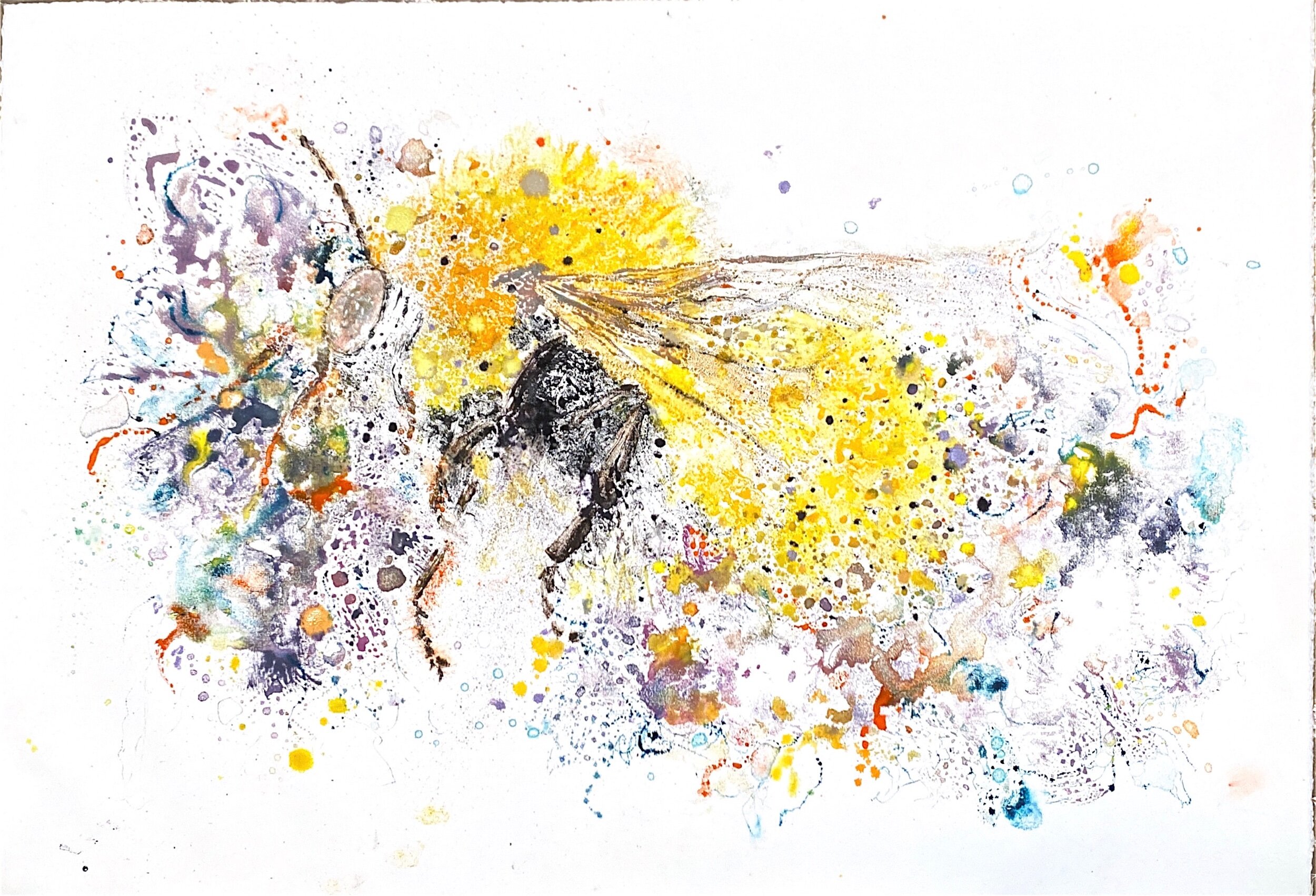
Bombus Morrisoni II

Bombus Morrisoni II Ghost
I was not happy with the first Bombus Morrisoni so I made more. The first is swimming in violet blooms

Bombus Morrisoni III

Bombus Morrisoni III ghost
Sometime in 2019 or late 2018 I discovered the USGS photographic library of wild bees. I was overwhelmed at the number of species and their individual beauty. They are jewels of the insect world. These facts combined with the reality that most well educated people believe that there is just one bee species - the honey bee. There are 20,000 species. How a creature who is responsible for our food could be misunderstood to this existent is baffling. Scientist just started realizing the error in their studies last summer. Committing to telling the story of the plight of the most important being on the planet is a worthy story. I have always felt the need to support underdogs.
Below us the artist statement for the project as I incusion it today. Artist statements remain fluid as I work on big projects.
RUMBLINGSA rumbling in the distance is nature's way to alert living creatures to their environment. Rumblings; monumentally draws attention to the 20,000 unknown species of threatened wild solitary bees. The bees that can not bee industrialized. The watercolor ink carefully manipulated on the fifty interconnected monotypes to reflect the synergistic, aqueous effect of; the unexplored bee species superior magnetic attraction of golden dust, the movement of the anonymous Keystone species dedication to pollinate, and their fragility due to the applied chemicals that flood industrial agriculture. With Rumblings, there is knowledge and knowledge is power; it is a resounding call to all for action.
The COVID 19 quarantine in March was a huge buzz kill to this series. These are all monotyoes. I use the plexiglass surface to create my water effect that I then press into the paper. I am very attached to this method as the best way to communicate this work for a few reasons. 1. It is a process I created and as far as I know no one else creates monotyoes with this type of mark making., 2. The watery look suggest the use if pesticides that are impacting their extension and lastly the tiny details that make up the bee is suggestive of pollen dust. I have been creating this pieces in MFAH beautiful Glassell studio school printmaking studio. With COVID that us not an option for me.
Since March, I have stitched bees and tried to be open-minded to another process to complete the series. I finally decided to see if I could hand press a 30” X 44” print in my studio.

Here I am applying the ink to the plexiglass. On the wall is a photo of Bombus Dahlbomii, the largest humble bee in the world at 2” long and endangered if it us not already extinct. The photographs are stunning. The photographs are taken if dead bees. In ny pieces, I try to put movement and energy back into the buzz pollinator.


Here I have just pressed the plexiglass with the watercolor ink bee image onto the wet paper. And surprise surprise surprise.

Bombus Dahlbomii IV
I have made three other attempts to print this monsterous fluffy ginger and not been happy with the results.

Bombus Dahlbomii IV Ghost.
The prior attempt are below. Getting a mono-colored fluffy bee with out muddying the ink was tricky.

Bombus Dahlbomii Day I

Bombus Dahlbomii Day I ghost

Bombus Dahlbomii Day II

Bombus Dahlbomii Day II ghost

Bombus Dahlbomii Day III

Bombus Dahlbomii Day I'll ghost
I am hoping the Bombus Dahlbomii day IV pieces cut the mustard. I am feeling hopeful and extremely excited that I can create monotypes without a press Is this non-verbal size.
“The soil is the creative material of most of the needs of life. Creation starts with a handful of dust.” - Dr. W. A. Albrecht ph. D.
That is a powerful thought. How important is soil to our health? For me it is clear.
And it is not dirt, it is not clay, it is humus living soil.
This quote is deeply tied to all of my current work, in The Endangered Knowledge piece that I am in the early stages of welding soil is the material that will become the protective layer of the keystone species, in Subterraneous Secrets soils energy is stabilized and captured through root systems, in Mute Testimony, it records its history, in Gust the life it provides is Endangered. In the photography of life in my cement pond, it establishes natural rhythms and compliments the other living systems. The pond is a complete ecosystem; it is free of pesticides and herbicides. In this type of ecosystem, even the blooms in their last phase of life are beautiful as the tiny microorganisms convert them back into minerals that build soil health. #inmycementpond In this image, you can not see the humus, but you can see the magic in the life it brings when we allow it to thrive in a natural state.

I just read an intesting article; how Cowbirds are hedging their bets when choosing surrogate birds to hatch and raise their young. Another instance that supports the theory that diversity is the ticket when it comes to the survival of a species.
Coincidently I picked up the bronze Cowbirds yesterday. They are ready for me to recreate the texture where they were damaged during the spruing process. Once that is complete I will deal with their patina. I should wait and decide on their finish once the abstract bison is further developed. That said I am excited to see how the materials will look in a polished finish. Below are closeups of each bird - just for the record.
The finishes are very powdery looking and flat because they were just sandblasted. When I decide on the patiba the textures will really show up.
I took a risk when I decided on the manner in which I would create the birds. The Cowbirds are constructed in a primitive manner. And they look extra primitive laying on the faux bois chair. Context impacts the way we see. I feel hopeful the organic and rough construction will work on the abstract beast they will be attached to. Roughly constructed they support the story, polished perfectly detailed birds would not relay their connection to the geography and mammals. I realize I have not taken the safe root and hope I didn’t need to hedge my by as the Cowbirds did theirs.

The big bird side 1

Opposite side.
On this image you can see a smooth surface from where the sprue was cur off. One spots the I will retexture.

From the top

Bird 2



Bird 3



Derail shot of bird 3 - you can see the seeds and grass stems.

Bird 4


As I recall this one gas some bluebonbet seeds in it's back feathers.

Bird 5


Texture gives me good goosebumps.
Subterraneous Secret is part of my Endangered Knowledge work. For several years, I have been researching grass-fed food production, attending soil conferences, and visiting regenerative ranches. Research in these fields shows how to fight desertification and reverse climate change through regenerative agriculture practices. Interestingly, this natural history of living soil, how it evolved with roots, fungus, plants, food, and animals, carbon and their essential roles within microbial communities in human health, is not common knowledge.

Subterranean Secrets II
bronze
Art/computer work that has interfered with my welding but I never miss an opportunity to collect native plants. I have converted an old kayak rack into a plant drying rack. Stacking up and drying out.
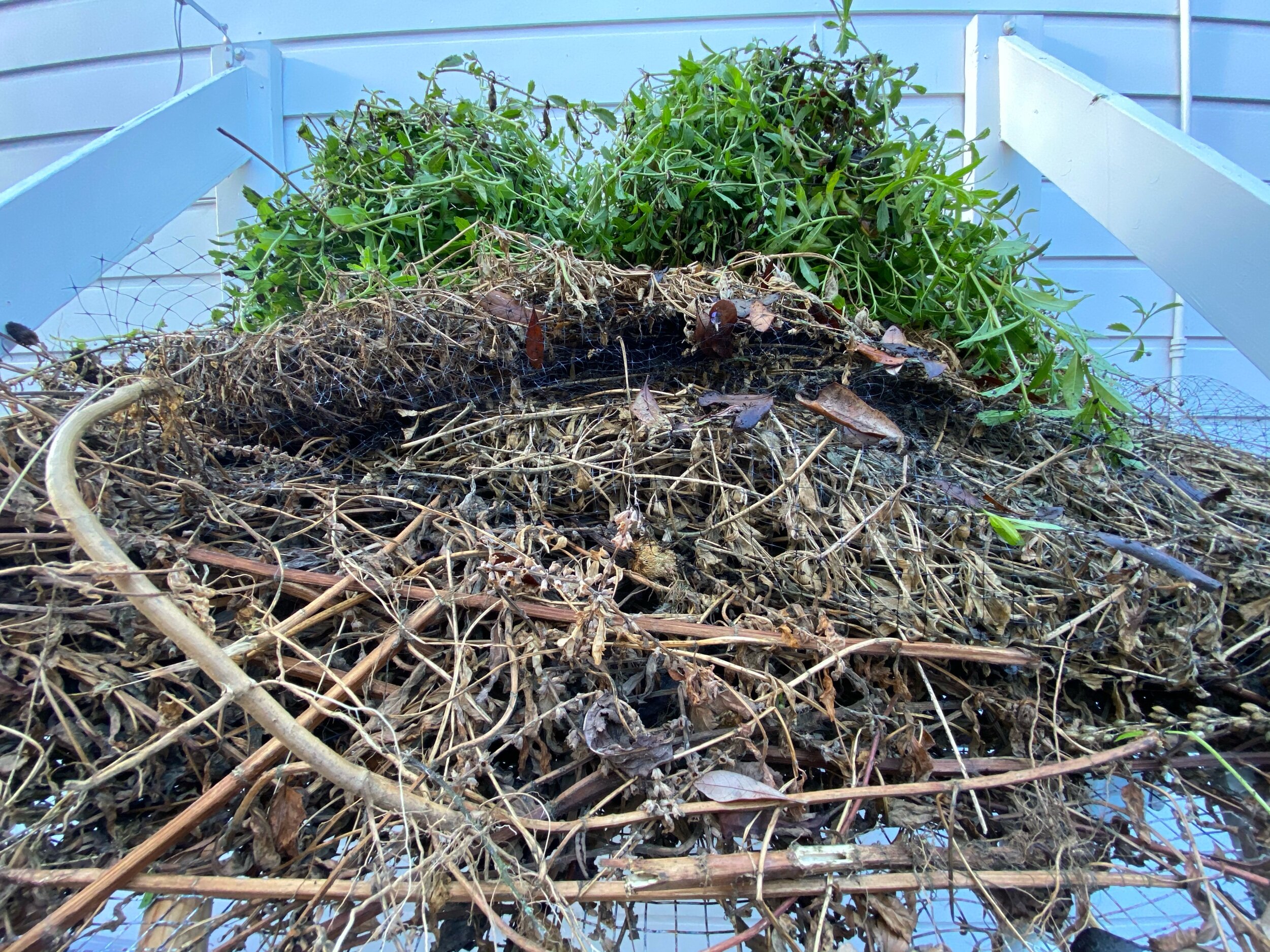
Drying native grasses
My goal for this piece is to embody joy, celebrate life, be complex yet straightforward, and have moments of imperfection.

I will attach to the wax sculpture red wax channels (sprues) and a brown wax cup.
Below the piece is sprued up and ready to dip.
The dipping process builds layer by layer a ceramic shell around the sculpture and sprues. Once the Shell is built I will burnout the wax leaving a hollow cavity to pour the bronze in.


Dip 1 Slurry only





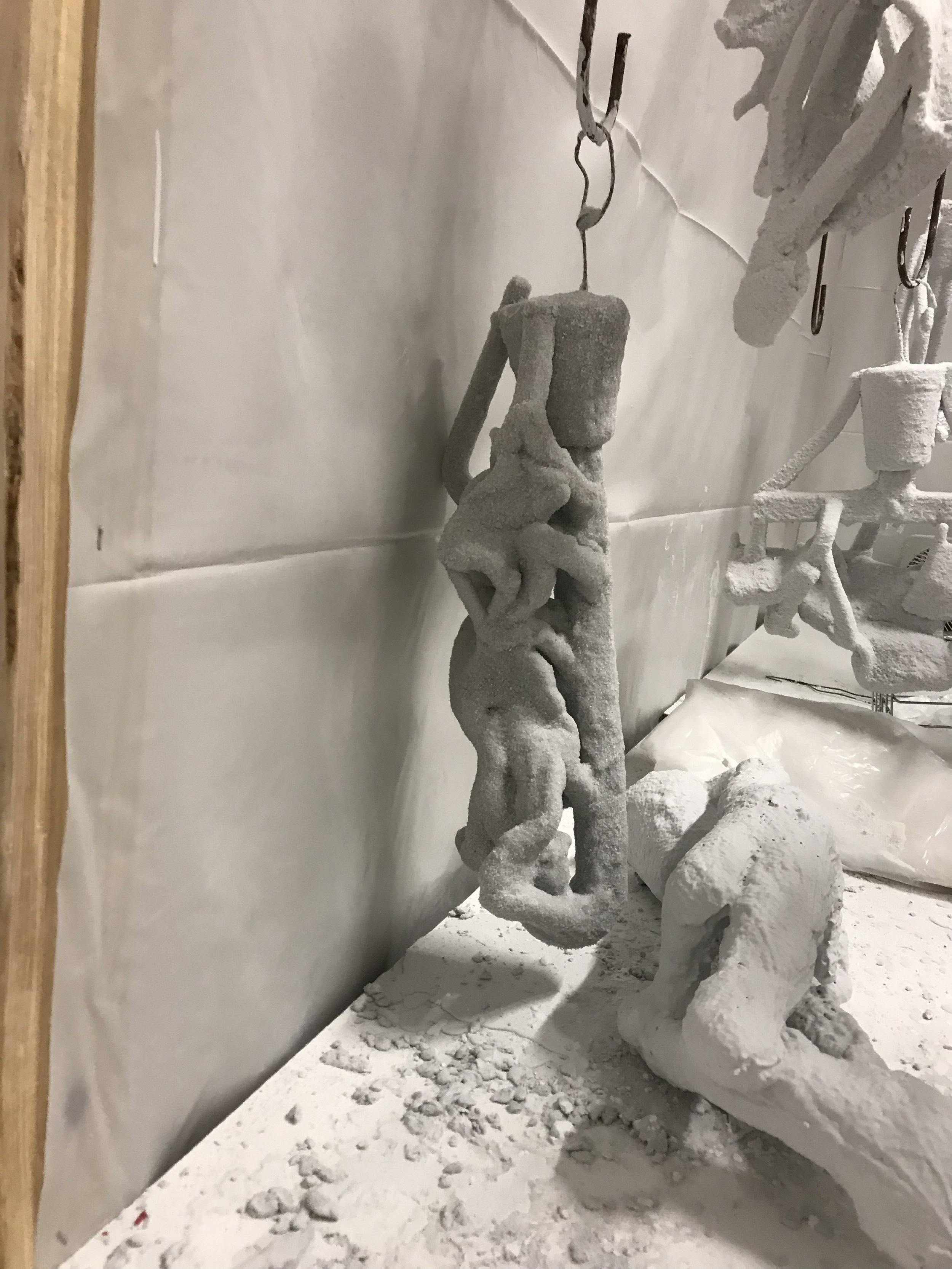



Final coat 24 hours after drying

Cutting the top of the cup and drilling holes to help the expanding gases escape when the wax is burned out.

The piece is now ready to be fired. The firing will harden the shell and melt out the wax sculpture, leaving the cavity for the bronze to be poured into. The wire sticking out will fall out when the wax is burnt out.

We poured the bronze into the shells last night. Now that the shell is cool it is time to break it off and see how it turned out.

the pour-

my shoulder has taken all the pounding it can. I will have to get help to finish breaking off the shell.
In the below images all the metal work is done and the piece is ready to patina.





Adding the white marble patina







Range by David Epstein - in my mind is a must-read for any artist, creative writer, inventor, scientist moms or anyone who solves problems.
https://pepperdine-graphic.com/book-review-lessons-for-higher-education-in-david-epsteins-range/
”Everyone needs habits of mind that dance across disciplines.”
- D. Epstein

“Habits of mind that dance across disciplines-“ - D. Epstein
I took time this weekend to photograph my studio- just for the memories. I never dreamed I would have an art studio.






One of the ppleasures of having a studio, Is it provides a space to meet with other artists, friends, and art lover acquaintances and get their reactions to my work? Everyone perceives art differently, and it is incredibly beneficial to get feedback from a variety of folks.

Today I worked on the lower part of it's cheekbones and then I added a rear jawbone.

Looking up the mouth and nose of head minus the lower jaw.

The old guys face left side

Looking through the skull

The right profile.
January 19, 2020


The ranch Anatolian livestock guard dogs greet us at the ranch entrance.

The herd including the cow to be culled having a relaxing morning grazing on Texas prairie grasses. The cow in question will not be separated from the herd, she will not be stressed and will not feel any pain. This is how you humanely harvest an animal. This is not how industrial Agriculture harvests meat.

Here is a collection of my reference material.

Bison grab a tuft of grass with their tongue, then they pinch it off by pressing it between their tongue and their front lower teeth. They do not have top front teeth. They then swallow it whole. That is the beginning of a 24-hour digestive process.

I love this image, I took it last January at Roam Ranch right before the roundup. I think this is the one they call Poppy. Poppy is very curious and friendly. She is checking me out as she catches rain drops on her tongue.

You can see the lower jaw through the upper jaw here. It is slightly off to the right of the bison. I want him chewing away and want to exaggerate the movement. I will probably bend it a little more askew this weekend.

Here the chewing lower jaw is more obvious.


View from the rear or top down.

Friday, I am committing to writing the Lawndale proposal- rewriting and rewriting and rewriting.
I am committed to walking 10,00-15,000 steps every day. During my walks, I listen to audiobooks or podcasts on subjects that interest me. A lot of them have to do with regenerative agriculture, the history of soil, native bees, and various Environmental issues. Often I switch it up and learn about something completely new to me. The information or music I absorb during my walks is a big influence on my work.
Below is a quicky Ted Talk that I was very excited to hear today. It supports my belief that environmental change has got to come from our people in our cities.
https://podcasts.apple.com/us/podcast/ted-talks-daily/id160904630?i=1000485487124
I sent the link to city councilwoman Sally Alcorn and her assistant Hannah. Who knows. Like the piet said- make sure your reach Exceeds your grasp.

I took a screenshot of the description. It feels good to hear other people who believe what I believe.

I needed to make some new concrete sculpting tools. I cut the bristles from a dog brush and glued them to the handle from a sponge 🤞
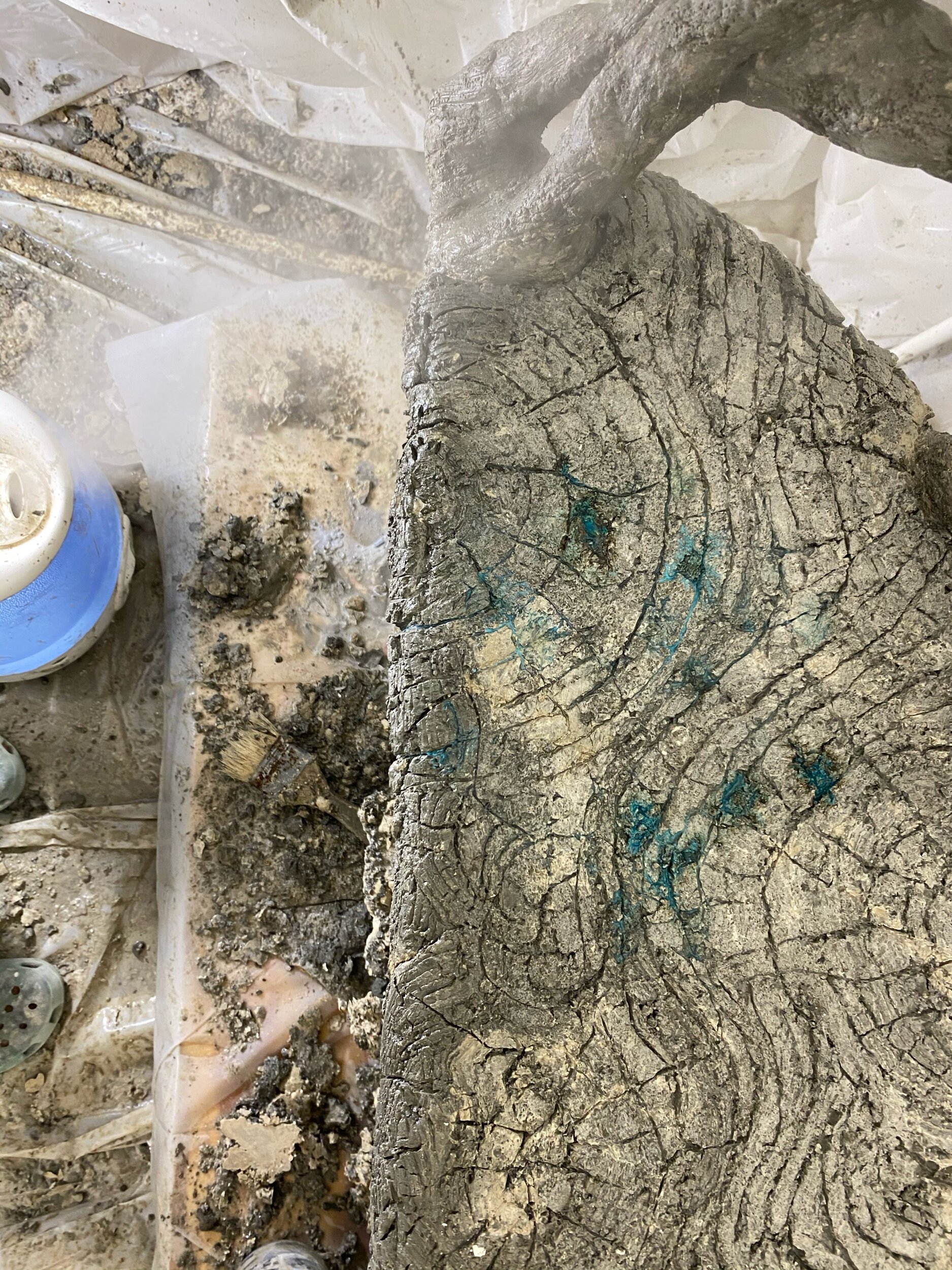
The small bronze root left a stain on the seat. Oops. I expect I can grind it out.

Work work work
I am getting close to finishing the head and upper jaw. The next step will be to create the lower jaw, then I will put the head aside and start building up the piece from the hooves.

More work on the cheekbones and connecting the horns to the eyes.

Side view of armature

Bottom side view

Bison's left side view

Back of head looking down
For the full story see Endangered Knowledge: The Soul of Humus #1a

View l from the mouth

The cheekbones are added.
For the full story see Endangered Knowledge: The Soul of Humus
My favorite measuring tool when building the armature is a sewing tape measure.


For the full story see Endangered Knowledge: The Soul of Humus
The head is a lot of detail work. Bending small pieces of steel takes time and strength. It is easy to bend large pieces of steel because I can use leverage to bend it. Small parts are too short To get much lecerage. This is the first time in my life strength is an issue., I have not been doing my regular weight lifting due to COVID 19 quarantine. So I have to think of creative ways to make the shapes I need. It takes longer to figure out.

Examining this work I have decided I need to raise the left horn.
I have only welded the horn in one location. This will make it easier to correctly position the horn once the head is connected to the body. I can find them if I want, or I can cut the one weld and resend them in the correct position.

I moved the horn and added the front of the upper jaw.

I added the back of the upper jaw and two pieces to stabilize the head. The stabilizing pieces run through the center of the head, the length of the face to the back If the skull. I used the angle grinder to separate the front and left sides of the front jaw separating the two stabilizing pieces. This will make it easier to make any adjustments in the head structure when it is finished and attached to the body.
The skin and coat of the finished piece is the most crucial part if this piece. This steel armature is purely structural.
For the full story see Endangered Knowledge: The Soul of Humus

I have cut the steel for two sets of horns, the center of the face, top of the scull and part of the nisee. .
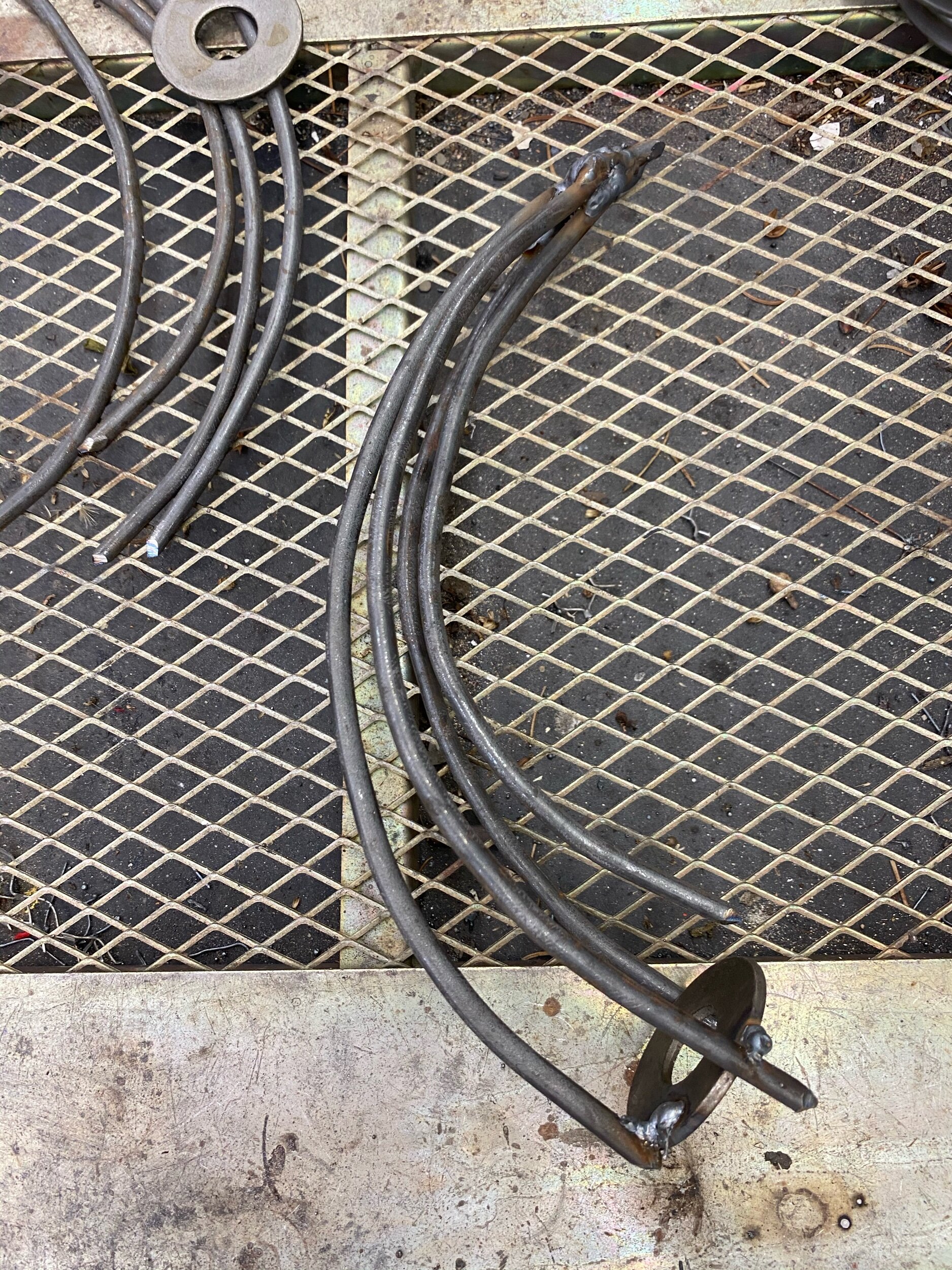
Working on the horns

This bison skull was a Christmas present. From Griffin and Alex my son and daughter in law. They have been unbelievably supportive of my environmental works. They are the best. The skull is proving extremely helpful in figuring out how to build the head armature.
For the Full story see Endangered Knowledge: The Soul of Humus
When I start to build a new piece the first thing I do is gather and organize all the reference images and information I am going to need.

I staple all the images to a piece of cardboard. This way it us easy to see as I work. This secti n focuses on the hoofs. I am starting with the hoofs.
For the full story see Endangered Knowledge: The Soul of Humus